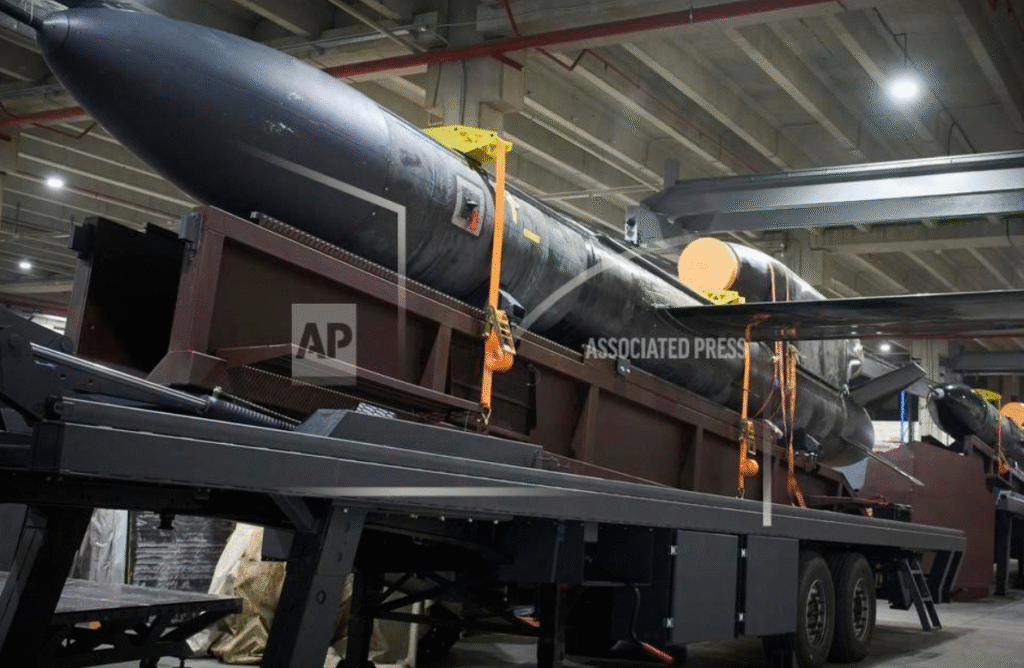On August 17, 2025, Ukraine unveiled the Flamingo cruise missile, a 3,000 km range domestically built weapon capable of striking deep inside Russia. With its massive 1,000 kg warhead, cost-effective production, and independence from Western restrictions, the Flamingo marks a turning point in Ukraine’s defense strategy and the Russia-Ukraine conflict.
Ukraine’s Flamingo Cruise Missile With 3,000 km Range Redefines the Russia-Ukraine War
On August 17, 2025, Ukraine unveiled its most advanced weapon to date: the Flamingo cruise missile. This domestically developed long-range strike system represents a major milestone in Ukraine’s defense capabilities, showcasing its determination to achieve self-reliance at a time when Western support remains uncertain and Russian aggression continues. The Flamingo is not just another addition to Ukraine’s arsenal; it is a statement of strategic intent and technological progress.
Specifications and Capabilities of the Flamingo Cruise Missile
The Flamingo Cruise Missile boasts an impressive range of 3,000 kilometers (1,864 miles), making it one of the longest-range cruise missiles in the world. This range allows Ukraine to target deep into Russian territory, including major cities such as Moscow and St. Petersburg, as well as strategic regions like the Ural Mountains and even as far as Novaya Zemlya. By comparison, the U.S. Tomahawk has a range of around 1,600 kilometers, while Russia’s Kalibr ranges between 930 and 1,550 miles. The Flamingo Cruise Missile clearly surpasses both.
Its warhead is another defining feature. With a payload of 1,000–1,150 kilograms, the Flamingo Cruise Missile carries more destructive power than the Tomahawk’s 450 kilograms or Russia’s Kh-101 with 400–450 kilograms. This heavy payload enables Ukraine to strike high-value targets, including arms factories, oil refineries, command centers, and air bases, with devastating precision.
In terms of design, the missile weighs approximately six tons and has a six-meter wingspan. Its overall structure is optimized for long-range strategic strikes, featuring a dorsal engine and a straightforward build that allows for mass production. The missile’s design bears similarities to the FP-5 cruise missile developed by the UK-Emirati Milanion Group, which was displayed at the IDEX-2025 defense exhibition.
The Flamingo Cruise Missile is subsonic, with a maximum speed of 950 km/h and a cruising speed between 850 and 900 km/h. While not as fast as hypersonic missiles, its low-altitude flight paths and potential use of decoys increase its survivability against advanced Russian air defenses. The missile also incorporates a combined guidance system with satellite navigation that is resistant to electronic warfare, making it less vulnerable to Russia’s jamming efforts.

Another critical advantage of the Flamingo Cruise Missile is cost. Reports suggest it is five times cheaper than the U.S. Tomahawk, which makes it suitable for mass deployment. Produced at Ukraine’s Fire Point defense facility, the missile is already in serial production. Videos shared by Ukrainian media, including ZN.UA, have shown successful launches from field platforms, confirming its combat readiness.
Strategic Implications
The introduction of the Flamingo Cruise Missile marks a turning point in the conflict. With its deep-strike capability, Ukraine can now target Russia’s critical infrastructure far beyond the front lines. This includes oil refineries, military production hubs in the Ural Mountains, and strategic air bases. Such strikes have the potential to disrupt Russia’s war economy and logistics, increasing pressure on the Kremlin.
The Flamingo also provides Ukraine with greater strategic independence. While Western-supplied systems such as the U.S. ATACMS and UK Storm Shadow have proven effective, their use has been restricted due to escalation concerns. The Flamingo, being an indigenous system, is not bound by these limitations. Its unveiling, timed just before President Volodymyr Zelenskyy’s meeting with U.S. President Donald Trump on August 18, 2025, sends a strong political message about Ukraine’s self-reliance.
The missile also represents a form of deterrence. Russia has launched over 11,466 missiles at Ukraine from September 2022 to September 2024, with particularly intense barrages in 2024 targeting Ukrainian infrastructure. By introducing a missile capable of striking deep into Russia, Ukraine aims to balance this asymmetry and impose costs on Moscow for continued escalation.
Ukraine’s Broader Missile Development Program
The Flamingo Cruise Missile is part of a much larger effort by Ukraine to build its own long-range strike systems. The Neptune missile, originally designed as an anti-ship weapon, became famous in 2022 for sinking the Russian cruiser Moskva. Upgraded versions now support land-attack missions with ranges up to 1,000 kilometers. In March 2025, Zelenskyy confirmed that the Long Neptune variant had successfully targeted Russian oil facilities.
Ukraine has also developed the Hrim-2 ballistic missile, with a 500 km range and a warhead of up to 500 kilograms. Test results in late 2024 indicated strong progress toward operational deployment. Additionally, systems like the Palianytsia missile-drone, with a 500–700 km range, and the Peklo missile-drone, with a 700 km range, demonstrate Ukraine’s capacity to produce low-cost but effective long-range strike options.
Other notable systems include the Sapsan ballistic missile, which entered serial production in June 2025, and a new ballistic missile with a 300 km range and a 400+ kg warhead, already tested in combat.
Ukraine’s Push for Domestic Arms Production
Ukraine’s defense industry has rapidly scaled up under wartime conditions. By November 2024, Ukraine had produced its first 100 missiles, and by April 2025, 40% of front-line weapons and 95% of drones were domestically produced. Zelenskyy has set a goal of producing 3,000 cruise missiles or missile-drones in 2025. The Flamingo plays a central role in achieving this target. International collaboration, such as potential technology transfers from the Milanion Group, has also supported Ukraine’s progress.
Challenges remain, particularly in scaling production during wartime and ensuring the survivability of subsonic missiles against Russia’s advanced air defenses. However, Ukraine’s tactical use of low-altitude flight and decoys may offset these vulnerabilities.
Political and Diplomatic Context
The unveiling of the Flamingo Cruise Missile comes amid uncertainty over U.S. policy. President Trump has pushed for a rapid end to the war, potentially involving territorial concessions, which Ukraine rejects. His administration has been reluctant to provide long-range weapons, making the Flamingo a vital tool for Kyiv’s strategic autonomy. While the U.S. did lift restrictions on using ATACMS in parts of Russia in late 2024, Ukraine fears this policy could be reversed.
Germany, however, has pledged to support Ukraine’s missile development without imposing range restrictions. Chancellor Friedrich Merz’s announcement in May 2025 marked a shift in Europe’s approach, providing Ukraine with more freedom to pursue long-range systems.
Russia’s response has been predictably aggressive. Moscow has warned of escalation if Ukraine conducts deep strikes, and Russian media have attempted to downplay the Flamingo by comparing it to outdated Soviet-era designs like the Tu-141. Nevertheless, Russia’s continued missile barrages—peaking at 1,110 missiles in August 2024—demonstrate why Ukraine’s new capability is essential.
Conclusion
The Flamingo cruise missile is more than just a weapon. It is a symbol of Ukraine’s resilience, determination, and technological innovation under fire. By combining range, destructive power, affordability, and independence from Western restrictions, the Flamingo gives Ukraine a formidable tool to reshape the battlefield. Its introduction underscores Kyiv’s commitment to sustaining its defense in the face of overwhelming odds and signals that Ukraine’s domestic arms industry is now a decisive factor in the ongoing conflict.

